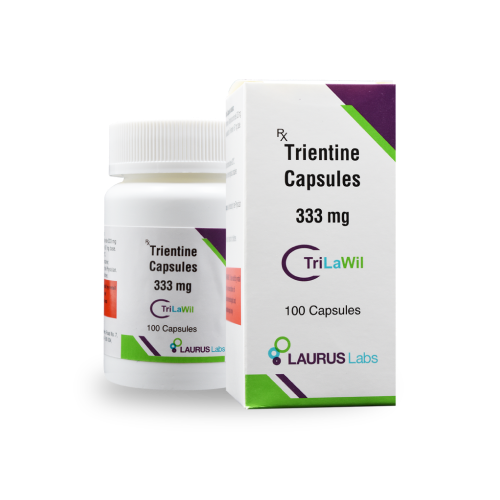
Trilawil is a prescription medication containing Trientine tetrahydrochloride, a copper-chelating agent used in the management of Wilson’s disease, a rare genetic disorder characterized by excessive accumulation of copper in the liver, brain, and other tissues. Trilawil helps remove excess copper from the body and prevents its re-accumulation, thereby reducing symptoms and preventing disease progression.
Trilawil (Trientine tetrahydrochloride) works as a chelating agent by binding free copper ions in the bloodstream and tissues to form a stable complex. These copper–trientine complexes are excreted via the urine, thereby reducing copper levels in the liver and other organs. Additionally, trientine enhances endogenous metallothionein synthesis, a copper-binding protein that reduces copper absorption in the intestine. Overall, this dual action helps maintain safe copper levels in patients with Wilson’s disease.
Trilawil is indicated for:
Standard Dosing: Trientine: 20 mg/kg/day in 2–3 divided doses (max 2 g/day).
Regular monitoring is essential to ensure safe and effective therapy:
Monitoring frequency should be determined by the treating physician, especially during initiation and dose adjustments.
Avoid concomitant administration with:
Wilson disease, also known as hepatolenticular degeneration it is a rare autosomal recessive disorder caused by gene mutations in the ATP7B gene leading to abnormal copper accumulation in the liver, brain, cornea, and other organs.
Trilawil begins to lower copper levels within weeks, but noticeable clinical improvements may take several months’ continuous use as body copper levels gradually decrease.
No. Wilson’s disease is not curable, but it is effectively manageable with lifelong treatment. Trilawil helps control copper accumulation and prevent complications.
Take the missed dose as soon as you remember, unless it is almost time for your next scheduled dose. Do not double doses to make up for a missed one.
Yes. Trilawil is approved for use in pediatric patients under medical supervision, with dose adjustments based on body weight.
Yes. Avoid high-copper foods such as shellfish, nuts, chocolate, mushrooms, and organ meats. A low-copper diet is recommended during therapy.
Trilawil should be used during pregnancy only if clearly needed and under medical supervision. It is not known whether it passes into breast milk; consult your physician before use.
Wilson’s disease requires lifelong treatment. Stopping medication may lead to rapid copper buildup and organ damage.
Do not stop Trilawil. Contact your healthcare provider because stress or illness may affect copper balance.
Yes. Regular copper studies, LFTs, CBC, and urine copper levels are required to safely adjust therapy.
Yes, in some cases Trilawil may be combined with zinc salts or antioxidants under medical guidance.
Yes. Genetic testing for ATP7B mutations is recommended for siblings and first-degree relatives.
Trientine hydrochloride was first approved by the U.S. FDA as an alternative chelating agent for Wilson’s disease. Clinical studies demonstrate its efficacy in reducing hepatic copper, improving neurological symptoms, and maintaining long-term remission in patients intolerant to D-penicillamine.
Therapeutic Efficacy and Safety of Trientine Tetrahydrochloride
Trientine tetrahydrochloride is the first drug in its class with an extensive and well-characterized pharmacodynamics, pharmacokinetic, and metabolism profile. Trientine is a selective copper chelator with a dual mechanism of action. As a systemic copper chelator, trientine eliminates absorbed copper from the body by forming a stable complex that is then eliminated through urinary excretion. TETA-4HCl was developed to address room temperature stability and adherence challenges.
The molecular structure of trientine has four amine groups that can bind hydrochloride. The stability challenges associated with its two unbound amine groups to oxidative reactions. These amine groups are sensitive to oxygen, water, temperature, and humidity, which can lead to product degradation over time. Moreover, interactions between these reactive amine groups and excipients may trigger the Maillard reaction, further exacerbating stability issues.
To overcome these stability challenges, the development of TETA-4HCl included the addition of two further hydrochloride groups to the molecule, so that all four amines are bonded to the hydrochloride moiety. This modification effectively neutralized all the reactive amine groups, resulting in a more stable molecule.
The phase I TRIUMPH study conducted in healthy subjects demonstrated that the median time to reach maximum plasma concentration was 2 h for TETA-4HCl provided more rapid absorption of trientine and greater systemic exposure in healthy subjects. Trientine tetrahydrochloride is supported by a well-characterized pharmacodynamics, pharmacokinetic, and metabolic profile demonstrating reliable and predictable dose linearity and dose proportionality kinetics.
For more information about Trilawil or to discuss whether this medication is right for you, consult your healthcare provider or geneticist specialist. This information is for educational purposes only and does not replace professional medical advice.
This information is for educational purposes only and does not replace professional medical advice. Trilawil is a prescription medication that should only be used under medical supervision.